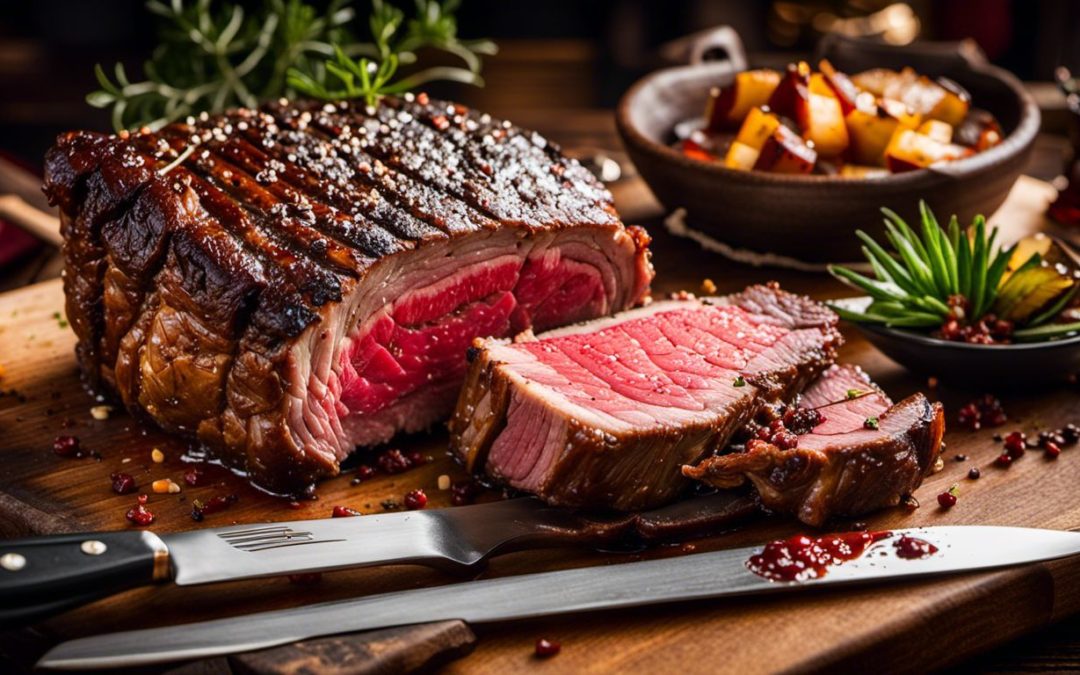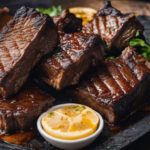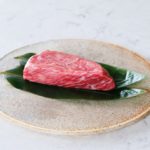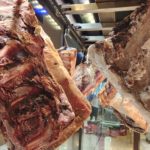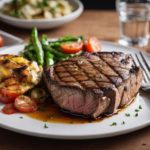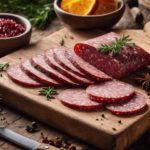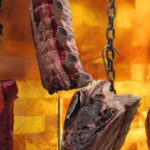Ever found yourself standing at the meat counter, puzzled over whether to choose prime rib or ribeye for your special dinner? Trust us, you’re not alone! It turns out that these two luxurious cuts of beef can be a source of confusion.
But here’s an interesting fact: both come from the same primal cut of beef, with subtle differences in flavor and texture. In this blog, we’ll dive into everything you’ve ever wanted to know about these two family favorites – their origin, cost factors, taste comparisons and much more.
Get ready for a culinary adventure that will enrich your steak game forever!
Key Takeaways
- Prime rib and ribeye are two different cuts of beef, coming from the same primal section of the cow.
- Prime rib is a larger cut that includes the ribeye and bone, making it juicier and more flavorful.
- Ribeye is a smaller portion without the bone, known for its tenderness and marbling.
- While prime rib tends to be more expensive due to its size, ribeye is more affordable and widely available.
Prime Rib vs. Ribeye: What’s the Difference in Steaks?
Prime rib and ribeye may sound similar, but they are actually two different cuts of steak.
Is ribeye the same cut as prime rib?
In the world of meat cuts, ribeye and prime rib hail from the same neighborhood – the primal section of beef. But they’re different in their own ways. Prime rib is a large, bone-in cut that includes the tender ribeye at its core.
We carve it out as a savory roast that leaves mouths watering with anticipation. Contrastingly, we collect the ribeye from a raw prime rib roast before cooking comes into play. Think of it as extracting an individual star player from the team – fully capable and worthy on its own, yet also part of something bigger! So while both come from similar territory and have their charm, don’t mix them up as being identical twins! They are more like siblings with unique personalities manifested through delicious juiciness (prime rib) or marbled tenderness (ribeye).
And that’s how these two steal your heart differently each time you indulge!
Which is better: ribeye or prime rib?
When it comes to the question of which is better, ribeye or prime rib, it really depends on personal preference. Prime rib is a larger cut that includes the ribeye and bone, making it a juicy slice from a larger roast.
It has more fat marbling throughout the meat, giving it an extra flavorful and succulent taste. On the other hand, ribeye is a smaller portion of the cow’s primal rib without the bone.
It is known for its tenderness and marbling. Some people prefer the juiciness and flavor of prime rib, while others love the tender texture of ribeye. Ultimately, both cuts are delicious in their own ways – you just have to decide what qualities you value most in your steak!
Which is more expensive: prime rib or ribeye?
Prime rib and ribeye are both delicious cuts of meat, but when it comes to price, prime rib tends to be more expensive than ribeye. This is because prime rib cuts are larger and include the bone, making them a bit pricier.
On the other hand, ribeye steaks are smaller portions and don’t have the extra bone. So if you’re looking for a more affordable option without compromising on taste, go for the ribeye steak.
Where Do Prime Rib and Ribeye Come From?
Prime rib comes from the primal rib section of the cow, while ribeye is cut from a larger rib roast or standing rib roast.
Prime rib
Prime rib is a larger, juicier cut that includes the ribeye and bone. It comes from a bigger rib roast and has more fat marbling throughout the meat, which gives it an extra juicy flavor.
Prime rib is often served as a whole roast and is perfect for special occasions or gatherings. Whether you prefer the tenderness of ribeye or the succulence of prime rib depends on your personal taste preference.
Both cuts are delicious in their own way, so it’s really up to you to decide which one suits your palate best!
Ribeye
Ribeye is a tender and flavorful cut of meat that comes from the rib section of the cow. It’s a smaller portion compared to prime rib, making it ideal for individual steaks. One thing that sets ribeye apart is its marbling – the fat that runs throughout the meat.
This marbling gives ribeye its juiciness and adds extra flavor. Because it’s sliced before cooking, ribeye is classified as a steak rather than a roast like prime rib. So if you’re looking for a delicious steak with plenty of flavor, look no further than a juicy ribeye.
Keep in mind that taste preferences may vary among meat lovers. Some people enjoy the tenderness and rich marbling of a well-cooked ribeye, while others prefer the larger slice and extra juiciness offered by prime rib.
Differences in Taste and Texture
Prime rib and ribeye have distinct differences in taste and texture.
Prime rib vs. ribeye taste and texture
When it comes to the taste and texture of prime rib and ribeye, there’s certainly a delectable distinction to be made. Let’s break it down and delve into the juicy details.
| Prime Rib | Ribeye |
|---|---|
| Prime rib features a generous amount of marbling, which is the distribution of fat within the meat. This gives it a rich, succulent flavor that’s incomparable. It’s often described as juicy and tender. | The ribeye, on the other hand, is highly sought after for its rich marbling as well, but it does carry a slightly leaner composition. This results in a tender, almost buttery texture that carries a robust, beefy flavor. |
| Because the prime rib includes a large bone, it also imbues the meat with additional flavor during the cooking process. This cut is often slow-roasted, which helps to break down the marbling and create a moist, melt-in-your-mouth texture. | The ribeye, being boneless, cooks quicker and offers a slightly different flavor profile. It’s popular for grilling or pan-searing and can deliver a delectably crispy crust with a tender, juicy interior. |
Both cuts have their unique attributes, and the preference often boils down to individual taste and cooking method. Whether you’re a fan of prime rib’s juicy richness or ribeye’s tender robustness, there’s no denying that both cuts offer a distinct and delicious beef experience.
Cost and Availability
Prime rib and ribeye steaks differ in terms of cost and availability.
Cost & availability of prime rib and ribeye
Prime rib and ribeye differ not only in taste and texture but also in cost and availability. Prime rib tends to be more expensive than ribeye due to its larger size and inclusion of the bone. This makes prime rib a popular choice for special occasions or upscale restaurants, where it is often served as a whole roast. On the other hand, ribeye is commonly available as individual steaks, making it easier to find at grocery stores or local butcher shops. So, if you’re looking for an affordable option with wide availability, ribeye might be your best bet.
Unraveling the Delightful Difference Between Ribeye and Prime Rib, key points
If you’re a beef enthusiast, you may have come across the tantalizing terms “Ribeye” and “Prime Rib.” But what sets these two cuts apart, and how do you make the most of each? This comprehensive guide will help you navigate the world of ribeye beef, exploring the differences, cooking techniques, and the delicious possibilities these cuts have to offer.
Understanding Ribeye Beef:
Ribeye is a steak cut renowned for its rich marbling, tender texture, and robust flavor. Cut from the rib primal section of the beef, this succulent steak is known for its exceptional taste and juiciness. The ribeye is often boneless, making it an easy-to-handle and versatile choice for various culinary creations.
Deciphering Prime Rib:
On the other hand, Prime Rib refers to a bone-in ribeye roast, and it is one of the most celebrated cuts in the world of beef. This magnificent roast comes from the rib primal cut, and when cooked to perfection, it offers succulent, flavorful slices that are a feast for the senses.
The Prime Difference: Ribeye vs. Prime Rib:
The key distinction between a ribeye and prime rib lies in their presentation and preparation. While ribeye is a standalone steak, Prime Rib is an entire roast that includes the rib bone, usually roasted as a whole piece. The ribeye’s signature “rib cap” or “deckle” is the outermost portion, which is known for its incredible tenderness and marbling.
Cooking Ribeye Beef to Perfection:
To enjoy the ribeye at its best, consider pan-searing, grilling, or broiling it to your preferred level of doneness. The marbling ensures a juicy and flavorful steak that is a true delight to steak lovers.
Mastering Prime Rib Roasting:
When cooking Prime Rib, the aim is to achieve a succulent and evenly cooked roast with a well-seasoned crust. Slow roasting at a low temperature, followed by a higher heat finish, is the secret to achieving a juicy, tender, and perfectly cooked Prime Rib.
USDA Prime Grade: The Epitome of Quality:
Both ribeye and Prime Rib can be found in the top-quality USDA Prime grade, which is the highest grade of beef in the United States. USDA Prime beef guarantees superior marbling and tenderness, elevating your dining experience to extraordinary levels.
Choosing Your Culinary Adventure:
Whether you prefer a juicy ribeye steak or an indulgent Prime Rib roast, knowing the difference between these two beef cuts empowers you to make a well-informed choice based on your culinary desires and preferences.
Conclusion
In conclusion, when comparing prime rib and ribeye, it’s clear that they have some similarities but also distinct differences. Both cuts come from the same primal beef cut and offer delicious flavor profiles.
However, prime rib is a larger roast that includes the ribeye and bone, while ribeye is a smaller, more tender portion. The choice between the two ultimately comes down to personal preference and how you plan to prepare your meat.
So whether you’re team prime rib or team ribeye, both options are sure to satisfy any meat lover’s cravings!
FAQs
What is the difference between prime rib and rib eye?
Prime rib refers to a specific cut of beef from the primal rib section, typically bone-in and well-marbled, while rib eye is a steak that is cut from the same area but can be boneless and may not have as much marbling.
Which cut is more tender, prime rib or rib eye?
Both cuts can be tender when prepared properly, but generally, prime rib has a reputation for being extremely tender due to its generous marbling.
Are there any flavor differences between prime rib and rib eye?
While both cuts come from the same area of the cow and offer rich flavor profiles, some people believe that prime ribs tend to have a slightly richer flavor due to the additional fat content.
Can I use prime rib instead of rib eye in recipes?
Yes, you can often use prime ribs as an alternative to rib eyes in recipes if you prefer a bone-in option with more marbling. However, cooking times may need adjustment since prime ribs are typically larger than individual steaks.
What is the difference between prime rib and rib eye?
A: Prime rib is a roast, while rib eye is a steak cut from the same part of the rib.
Is prime rib the same as ribeye roast?
A: Yes, prime rib is often referred to as ribeye roast.
Are prime rib and standing rib roast the same?
A: Yes, prime rib is also known as standing rib roast.
What is the difference between prime rib and rib steak?
A: Prime rib is a larger roast, while rib steak is a smaller individual steak cut from the rib section.
Can you explain the difference between a prime rib and a ribeye?
A: Prime rib is a larger cut of beef that includes the entire rib section. Ribeye, on the other hand, is a smaller steak cut from the rib section.
What is rib cap?
A: Rib cap is the outer edge of a ribeye steak that is highly marbled and known for its rich flavor.
What is the difference between a ribeye and a boneless ribeye?
A: The main difference is that a boneless ribeye is a ribeye steak without the bone, while a ribeye steak includes the bone.
Can you reheat prime rib?
A: Yes, you can reheat prime rib by using the oven or a microwave. It is recommended to heat it slowly to prevent overcooking.
What is a cowboy ribeye?
A: A cowboy ribeye is a bone-in ribeye steak, known for its large size and flavor. It is also called a cowboy cut ribeye.
Where is prime rib located on the cow?
A: Prime rib is located in the rib area of the cow, specifically between the sixth and twelfth ribs.
Greetings!
With over two decades of diverse experience in the meat industry, I proudly stand as an expert in all things meat. My journey commenced with a strong foundation in hospitality, where I honed my culinary skills as a chef in prestigious restaurants and on luxurious superyachts worldwide.
However, my true passion lies in the art of butchery. Throughout my extensive career, I have had the privilege of working with renowned meat purveyors and mastering the craft of meat cutting and preparation. From breaking down whole carcasses to meticulously selecting prime cuts, my butchery expertise is at the core of my meat knowledge.
Having immersed myself in various cultures and cuisines, I have honed my skills to deliver exceptional dining experiences, crafting delectable dishes that celebrate the natural flavors of different meats. Whether it's sourcing the finest meats for discerning clients or sharing valuable tips on meat selection and cooking, I take pride in elevating the meat experience for both professionals and enthusiasts.
My journey has taken me from the bustling kitchens of top-rated restaurants to the heart of meat processing facilities, gaining insights and honing my skills to become a true meat connoisseur. Now, I am enthusiastic about sharing my expertise, offering valuable insights on meat selection, cooking techniques, and the art of butchery.

